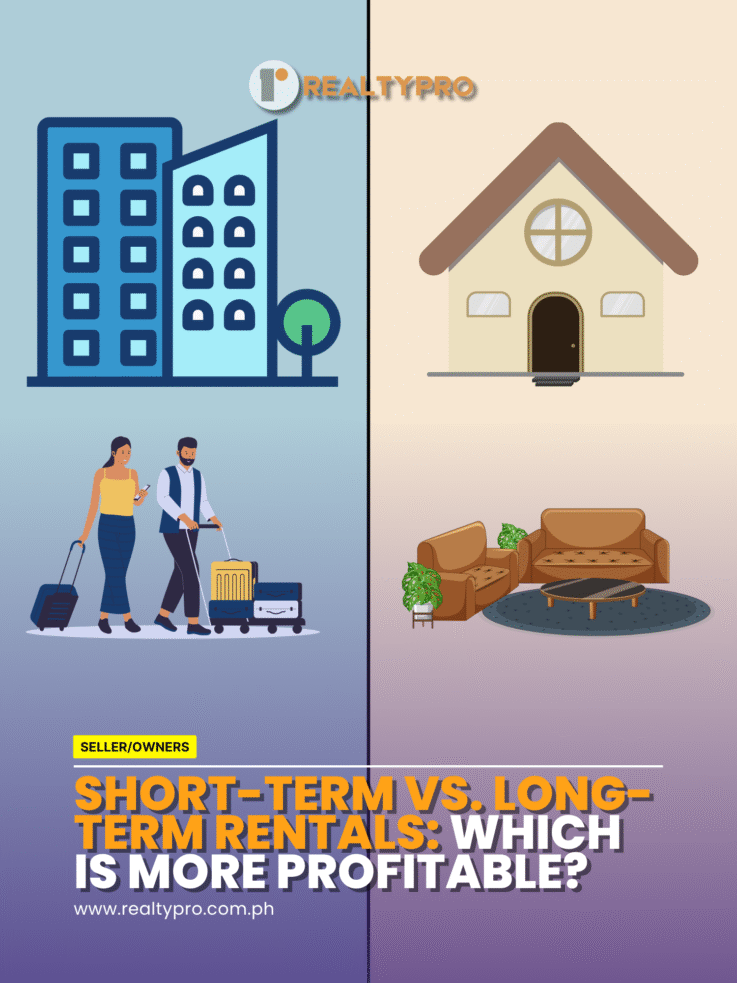Short-Term vs. Long-Term Rentals: Which is More Profitable?
In the world of property investment, one question often pops up among both newbies and seasoned landlords:
“Mas kikita ba ako sa short-term rentals or long-term rentals?”
The Philippine real estate market offers opportunities for both, but choosing the right rental strategy can make a huge difference in your profits, peace of mind, and overall experience as a property owner. Let’s break down what each option means and explore which can potentially give you the better return on your investment.
What is a Short-Term Rental?
Short-term rentals are typically leases that last from a few days to several weeks. In the Philippines, these are often found in tourist hotspots like Boracay, Palawan, Baguio, Tagaytay, and Metro Manila condo units near business hubs. With platforms like Airbnb, Booking.com, and Agoda, property owners can list their homes or condos for transient guests looking for flexible and furnished accommodation.
Pros of Short-Term Rentals:
✅ Higher nightly rates — You can charge more per night compared to monthly rent.
✅ Flexibility — You can block off dates for personal use or maintenance.
✅ Opportunity to adjust pricing — Rates can change depending on demand (e.g., peak seasons, holidays).
Cons of Short-Term Rentals:
❌ High turnover = more work — Expect frequent cleaning, maintenance, and guest communication.
❌ Unpredictable income — No guarantee of bookings, especially during off-peak seasons or economic downturns.
❌ Regulatory concerns — Some condo buildings or LGUs impose restrictions on transient rentals.
What is a Long-Term Rental?
Long-term rentals typically involve leases of six months or more, with most landlords offering one-year contracts. These are preferred by students, employees, expats, or families looking for stable housing.
Pros of Long-Term Rentals:
✅ Stable and predictable income — You can rely on fixed monthly rent.
✅ Lower operational costs — Less frequent cleaning and maintenance compared to short-term rentals.
✅ Less management hassle — No need to constantly market your unit or deal with guest turnover.
Cons of Long-Term Rentals:
❌ Lower income ceiling — Monthly rates are generally lower compared to short-term nightly or weekly rates.
❌ Difficult tenant replacement — If a tenant leaves unexpectedly, it may take time to find a new one.
❌ Less flexibility — Once leased, you can’t easily use the unit for yourself or adjust rent until the lease ends.
Which is More Profitable?
Profitability depends on several factors:
🏙 Location — Properties near tourist attractions, business districts, or transportation hubs are better suited for short-term rentals.
📈 Market demand — In areas with consistent demand for tourists or business travelers, short-term rentals can outperform long-term ones.
💼 Your capacity to manage — Do you have time or can you hire someone to manage bookings, cleaning, and guest needs? Short-term rentals require more hands-on work.
For example, a well-managed short-term condo unit in BGC or Makati can potentially earn double or triple the income of a long-term lease. But if occupancy rates drop or guest reviews are poor, income can dry up fast. Meanwhile, long-term rentals offer steady cash flow with fewer surprises.
Final Thoughts: Ano Ba Ang Mas Okay?
Sa totoo lang, walang one-size-fits-all answer.
Kung kaya mo i-manage ang hassle at gusto mo ng higher potential income, short-term rental ang bet mo.
Pero kung priority mo ang peace of mind at stable na kita, mas bagay sa’yo ang long-term rental.
Importante, i-assess mo ang location ng property mo, ang target market, at syempre, ang kaya mong i-handle.
Sa dulo, ang pinaka-profitable na strategy ay yung bagay sa lifestyle mo at goals mo bilang landlord.
Read the latest Blog – OFW, Old Friends, and Overeager Sellers: How Not to Buy a Lot on the Spot
Like & Follow our Page – Facebook



One Comment